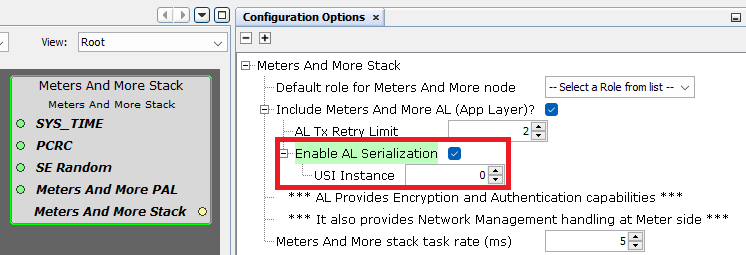1.1 Configuring The Meters And More Stack
The Meters And More Stack Configuration is centralized in the component with the same name.

Default Role for Meters And More Node

- DCU (Master) Node. This node is the one in charge of Discovering all the other nodes in the network, and the routes that are needed to reach them. It is also the initiator of every Data Exchange that occurs in the network.
- Meter (Slave) Node. This node acts as a server, both for Network Discovery and for Data Exchange. In both cases, this node only sends data when it is required to do so, as a response to a previous request initiated by Master Node.
This option just configure the default role for the node. The role can be configured dynamically through LLC_IS_DCU_IB IB attribute.
Meters And More AL (App Layer)
Enabling this option includes the files needed to provide Encryption/Decryption and Authentication capabilities to the Meters And More implementation.
According to Meters And More standard, Encryption and Authentication are out of scope of the DLL layer, and are part of Application layer, thus the name for this module (AL or App Layer).
This module also provides Network Management commands handling at Meter side, i.e. responding to Address Request and Request Address Request Commands, without user application intervention.
AL offers an additional configuration parameter, which is Tx Retry Limit. When a transmission is requested to AL, DLL Data Request is invoked, and in case a transmission error occurs, such transmission is retried for “AL Tx Retry Limit” times before returning an error to User Application.

In addition, AL API can be accessed from an external Host using a Serial Interface. To do so, USI module is used, and thus it has to be properly configured (refer to Smart Energy documentation). When Serialization is enabled, the USI instance to use has to be set, as shown in the figure below.

Meters And More Task Rate

This parameter defines the rate at which the Meters And More State Machines are executed.
Range for this parameter is defined from 1ms to 20ms, with a default value of 5ms.
Selection may depend on latency needs for the network, and/or platform capabilities for tasks execution.
RTOS Settings
- Stack Size (in bytes). Stack size in bytes for Meters And More Stack task.
- Task Priority. Priority for Meters And More Stack task inside the RTOS scheduler.
